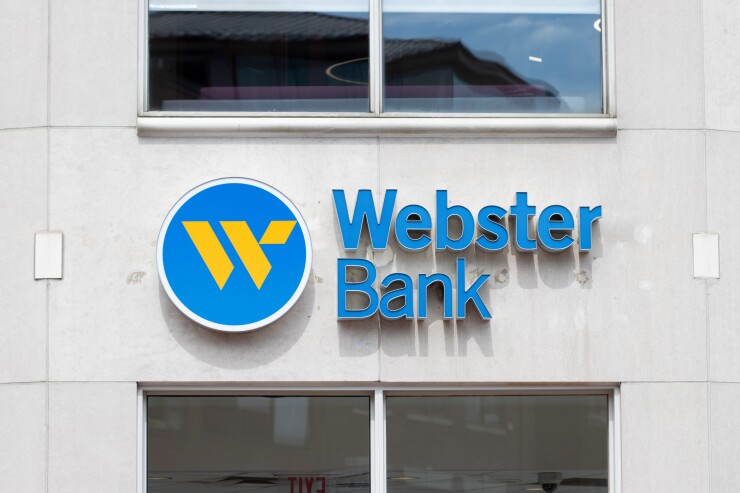
Webster Financial is expecting a financial boost from favorable health savings account provisions in the tax legislation signed recently by President Donald Trump.
Stamford, Connecticut-based Webster is one of the largest health savings account providers in the country — along with Kansas City, Missouri-based UMB Financial — and had been
Now that the law has been signed, those tailwinds are expected to materialize, Webster President and COO Luis Massiani said during a call with investors Thursday morning.
"These provisions will significantly increase the addressable market for the HSA industry and HSA Bank," Massiani said, referring to Webster's health savings account unit.
He explained that Webster will benefit from provisions in the legislation that make certain Affordable Care Act plan participants eligible to fund HSA accounts. The law decouples health savings accounts from their historical niche with high-deductible insurance plans.
Webster expects a potential deposit opportunity of between $1 billion and $2.5 billion over the next five years, starting with "incremental growth" of $50 million to $100 million in 2026, Massiani said.
"There is likely to be a somewhat lengthy ramp-up period for adoption, as newly eligible consumers begin to understand the benefits of an HSA account and how best to use it for their health and financial wellness," he said.
Webster is optimistic that additional HSA provisions that were initially included in the tax bill but didn't make the final cut could be included in another reconciliation bill, providing additional momentum for the company's health care business.
"If all of the provisions that were in the original spending bill passed by this House were to become law, we believe this could double our range of opportunity for incremental deposits," Massiani said.
Webster's top-line performance in the second quarter beat analysts' expectations. Revenue came in at $715.8 million, 17% higher than the same reporting period last year. That figure just edged out analysts' consensus of $712 million.
Net income tallied $251.7 million, or $1.52 per diluted share, compared with $175.5 million, or $1.03 per diluted share, in the second quarter of 2024. Analysts had expected net income of $235.7 million, or $1.41, according to S&P Capital IQ.
Other top-line financial metrics also showed year-over-year growth. Net interest income came in at $621.2 million, an 8.5% increase, while the bank's net interest margin landed at 3.44%, an increase of five basis points from the year prior.
The yield on $74 billion of interest-earning assets decreased by 21 basis points when compared with last quarter, but was offset by a 31 basis-point decrease in the cost of deposits and interest-bearing liabilities.
Webster is expecting its net interest margin to remain at approximately 3.4% through the rest of the year, based on the assumption that the Federal Reserve will cut interest rates twice, according to Chief Financial Officer Neal Holland.
Loans and deposits increased during the second quarter. Average loans and leases notched up 3.6% to $53.3 billion, and average deposits grew 6.9% to $66 billion.
Other guidance was also unchanged. "The financial results put our company on a trajectory to meet the outlook we established in January despite a less certain macroeconomic picture at points in the first half of the year," CEO John Ciulla said.
The regional bank's deposit growth, which outpaced peers, was a key component of its profitability growth in the quarter, according to a research note by Citigroup analyst Benjamin Gerlinger.
He wrote that the bank's loan growth and its relatively high loan yields "have consistently generated a stronger-than-peer NII revenue trend." Gerlinger said.
During the second quarter, noninterest income surged 124% from the year-ago period to $94.7 million. Expenses rose 6% to $345.7 million, largely due to investments in human capital and risk management infrastructure, according to the bank's earnings release.
Credit performance improved on a linked-quarter basis, but inched down on a year-over-year basis. Net charge-offs landed at 0.27% of average loans and leases, down 15 basis points from the previous quarter but up 1 basis point from the year-ago period.
Provisions for credit losses were $46.5 million, compared with $59 million in the same reporting period last year. The allowance for loan losses coverage ratio hit 1.35% of total loans and leases, compared with 1.3% in the second quarter of 2024.
The bank's common equity Tier 1 ratio was 11.33%, a seven-basis-point increase from the prior-year period.
Gains in the bank's health care and consumer banking segments offset declines in its commercial banking division, according to the bank's release. In the Healthcare Financial Services unit, interest income jumped 6.5% from the year-ago period to $97.6 million, and noninterest income increased 4.4% to $28.7 million. Noninterest expenses fell 8.2% to $55.4 million.
In consumer banking, net interest income increased 5% from the second quarter of 2024 to $212.6 million, and noninterest income inched up 1% to $24.6 million. Noninterest expenses fell 6.2% to $123 million.
Webster's commercial banking operations posted weaker results in comparison with the second quarter of last year. Net interest income in the commercial banking unit fell 6% to $318.5 million, and noninterest income fell 11% to $30.6 million. Noninterest expenses increased 3.6% to $108 million.
Shares in Webster were trading at $58.50 per share as of 12:22 p.m. in New York, relatively flat from market open.





